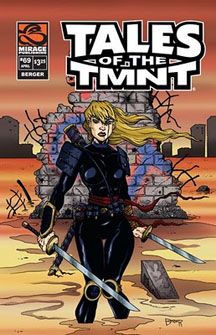“TMNT” long ago taught us that, in the end, life is at best bittersweet, and that’s how I’d describe the last year-and-a-half of “Tales of the TMNT” Volume 2, which delivered some outstanding issues but ultimately ended with many threads unresolved.
Back to the dark future
Still, at least it delivers a major moment in the dark Mirage Turtles future that had been hinted at so many times: Dan Berger’s Issue 69 (“Dark Shadows”) shows the Utroms evacuating many humans as the ocean levels rise, and it shows Shadow taking a rowboat to various NYC buildings in this future of wiped-out coastal cities.
While it is by no means a tidy bow on the Mirage Future mythos, it at least is a juicy nugget for speculative analyses on the Mirage saga’s future such as Mark Pellegrini’s excellent essay over at TMNT Entity.

“Tales of the TMNT” Volume 2 Issues 54-70 (2009-10)
Writers: Andrew Bonia, Dan Berger, Tristan Huw Jones, Stephen Murphy, Ryan Brown, Jake Black, Eric Talbot
Pencils: Bob LeFevre, Jim Lawson, Paul Harmon, Dario Brizuela, Andres Ponce, Fernando Leon Gonzalez, Dan Berger
Inks: Mostafa Moussa, Paul Harmon, Jim Lawson, Dario Brizuela, Steve Lavigne, Dan Berger, Andres Ponce, Eric Talbot
Issue 69 is a real downer. In addition to showing the future Earth with its coasts under water, it also tells us that in the future, Raph purposely scars Shadow’s face (as Leo had done to Cha Ocho) over something she accidentally did to Donatello, and then Shadow – having perhaps surpassed her sensei’s ninja skills — returns the favor in a fight, thus revealing to readers why Future Raph has an eyepatch.
The emotionlessness of their skirmish is the real heartbreaker for readers. Shadow thinks:
“He is holding back. … We both are … Despite all our woes, it’s still Unca Raph and his little princess. … But there’s no love here. Not from either side. Just … nostalgia.”
It’d be interesting to learn how the entire Mirage team got on the same page of making every future-based story written over the course of 25 years consistently bleak. It’s generally intriguing stuff, but it’s weird how – considering the varied interests of all the writers – they all got on the same page when it came to depressing the hell out of their readers.
Caring about characters
For the most part, Mirage used these final issues to get to the heart of why we love TMNT: the characters. I had always kinda liked Fugitoid; in the same sense as C-3PO and R2-D2 in “Star Wars,” he provides a detached scientific perspective to the stories while abhorring violence in a very human way.
Issue 54 (“Mere Appendix”), by Andrew Bonia, is the best Fugitoid character piece out there as he has to make self-repairs and frets over whether he really is Professor Honeycutt or merely a copy.

Other good character work is done in Issue 56 (“Hun”), where we learn that a young Casey suffered a serious concussion from brawling with street tough Hun, who – along with the Foot mystics – is one of two examples of a “TMNT” character starting in another medium (in this case, the 2003 cartoon) and later being added to the Mirage-verse.
A different kind of crossing-over comes into play as the four-issue C.O.W.-Boys of Moo Mesa saga – easily my least favorite arc of “Tales” Volume 2 — finally concludes in Issue 58 (“All Tomorrow’s Yesterdays”), by Steve Murphy.
The Turtles briefly glimpse various worlds of the multiverse, including Archie’s Turtles fighting Krang, Bebop and Rocksteady. The word “multiverse” would pop up more often in these final issues, perhaps as the idea for the late-2009 TV movie “Turtles Forever” began to coalesce in Peter Laird’s mind.
While Casey gets his backstory fleshed out in Issue 56, the Mirage-verse’s second-best vigilante superhero, Nobody, gets his future-story fleshed out in Issue 60 (“Nobody Does It Better”), by Berger. We never got the Nobody origin story we really needed, but at least fans got a “sorry ’bout that” with this story, where it turns out that Nobody didn’t die in stupid, throwaway fashion in Volume 2, Issue 12.
He survived being “eaten” by the alien starfish, although his memories are a bit fuzzy, and he continues his vigilante crime-fighting, only now with a white jumpsuit instead of black, befitting a good guy (but it’s not as good for stealth, so I hope it doesn’t get him killed).
Leatherhead and the Rat King
Two of the classic rogues’ gallery characters – Leatherhead and the Rat King — make one last appearance in this batch (although in the Mirage universe, neither of them are outright villains, and in fact Leatherhead is a pal of the Turtles). Issue 63 (“Monster Island”), by Berger, is an unnecessary but fun coda to the fan-favorite Issue 50, as Leatherhead-hunter Marlin finally gets what’s coming to him.
And the Rat King visits a meditating Splinter to warn of an evil sorcerer preparing to send snow beasts after the Turtles at the Northampton farm in Issue 65 (“Cold, Cold Ice”).
This issue continues Mirage TMNT’s proud tradition of telling heartwarming Christmas stories, and for that matter, Issue 66 (“There’s No Place Like Home”), also by Berger, is sort of a spiritual sequel to the “Michaelangelo” one-shot. There, Mikey adopted Klunk the kitty; here, he aims to foil a dog-napping ring and return the pups to their owners.
Never-ending war
Issue 59 (“Expose” by Tristan Jones) is a chapter in the “Gang Wars” arc characterized by Paul Harmon’s heavily shaded art. “Gang Wars,” one of the most lamented unfinished arcs of “Tales” Volume 2, intended to show the post-“City at War” machinations of the Foot Clan (split into Shredder Loyalist and Karai Loyalist factions) and the NYC crime scene in general (with the Purple Dragons re-emerging, led by a musclebound man named Hun).
Most notable about “Expose” is that Jones cribs heavily from the first “TMNT” movie, creating a darker version of April’s investigation into the Foot Clan rumors. The Mirage equivalent of Reporter April is Lauren Stanton, an investigative newspaper reporter at the Bullet. Her boss is named Charles Pennington, and he tells her to get off the story, as he’s receiving personal threats from those tangled up in the criminal scene, including corrupt cops.
As she skulks around the corners of secret meetings, the Turtles rescue her – at first in the dark, as they knock out a streetlight a la the movie. Later, she sees quite clearly what Mikey looks like, and the Turtles take her phone and camera. They return the items to her via the mail with the photos deleted, albeit with a friendly note that says they believe she’d be more accepting of their kind than most.
(This story is set before the Utrom visit in Volume 4 that allows the Turtles to show themselves in public, passing as aliens, so they are still lying low whenever possible.)
It can get darn frustrating reading some of these “To be continueds.” Another story that never ends is Jones’ Issue 64 (“The Burning Man”), which ends with a panel of a group of Stonecutter-types – including a snake-looking leader who calls to mind Playmates’ Scale Tail action figure — who aim to “kill the freaks” and “destroy the Foot.”
Sweet stories
The Mirage team understands the “sweet” part of “bittersweet,” too. If you want a happier Shadow yarn to go out on, check out Issue 67 (“Schooled”), by Berger, where Shadow spends all of about 10 minutes in a snobby private school before punching one of the snobs and getting expelled. A highlight is Raph and Casey tearing up as they help Shadow get ready for her first day: “Our little girl is growing up so fast!”
Issue 57 (“Gangs All Here”) is a nice fill-in-the-gaps story that’s set at the end of Volume 2 and quite nicely leads into Volume 3 (despite Laird declaring Volume 3 non-canon). The Turtles argue about whether they should live in April’s apartment (which now has a Purple Dragon leader living next door), in the sewers, in the abandoned church or at the farm. They decide on all of the above, just so long as – in contrast to the beginning of Volume 2 — they stick together.
Issue 62 (“Adventures in Bunnysitting” by Ryan Brown and Dan Berger) is a nice Mike and Raph piece. These two have always been best buds in the Mirage universe, and that’s emphasized here as everyone else is absent without explanation.
Hurting from the loss of Klunk – the old wounds are opened up when Mike goes through some photos – Raph suggests they go out for ice cream (this is in the Volume 4 period when they can go out in public). Leatherhead and the Utroms, hoping to help Mike with his pain, give him a rabbit from their lab to bunnysit.
The rest of the yarn is worth smiling at as Raph – who just wants to watch the Syracuse football game (is one of the guys behind this issue a Syracuse grad?) – is instead menaced as the bunny (whom Mike adores) mutates into a horrific creature.
The punchline, of course, is that Mike returns home to a wrecked lair and thinks Raph has exaggerated the whole thing. Humorously, the opening editorial says this story was based on Kevin Eastman’s and Steve Lavigne’s experience bunnysitting for Brown.
The best issue in this batch, and my favorite “Tales” issue of all, is Berger’s Issue 55 (“Day in the Life”). This story chronicling one day of Splinter training the pre-Volume 1, Issue 1 Turtles was probably put together in the subconscious of every die-hard TMNT fan, and it’s a lump-in-the-throat moment when Berger finally delivers it for real.
He nails all of the brothers’ personalities and delivers a particularly sweet moment of reconciliation between the moody Raph and the goofy/annoying Mike when Mike fixes Raph’s teddy bear.
Of course, this being “Tales” Volume 2, Berger can’t resist adding a future-set epilogue where Eyepatch Raph and an on-the-fritz April robot (!) sit around a fire on a rooftop. Raph looks at the teddy bear and says “Good night, Mikey … wherever you are.”

